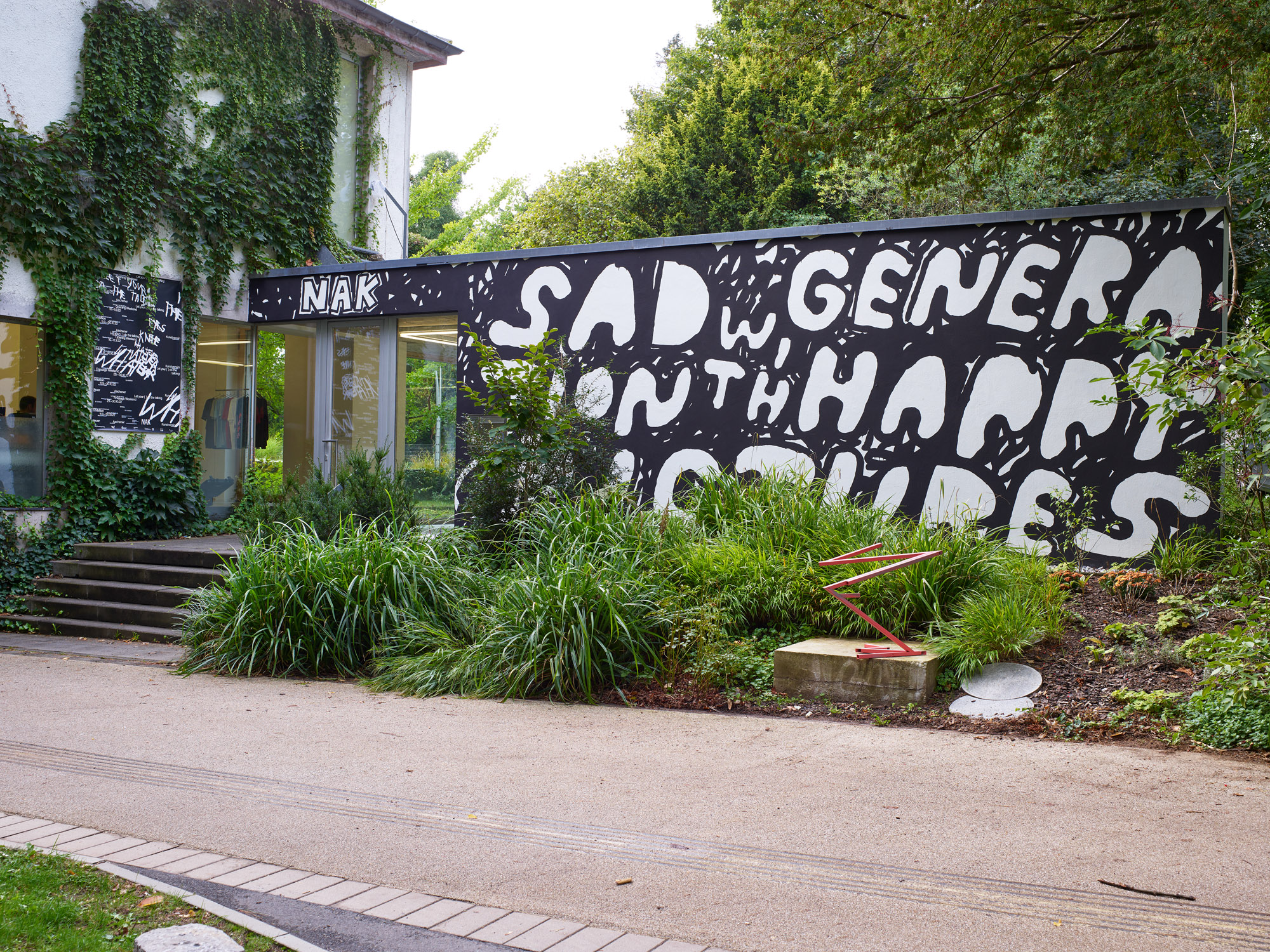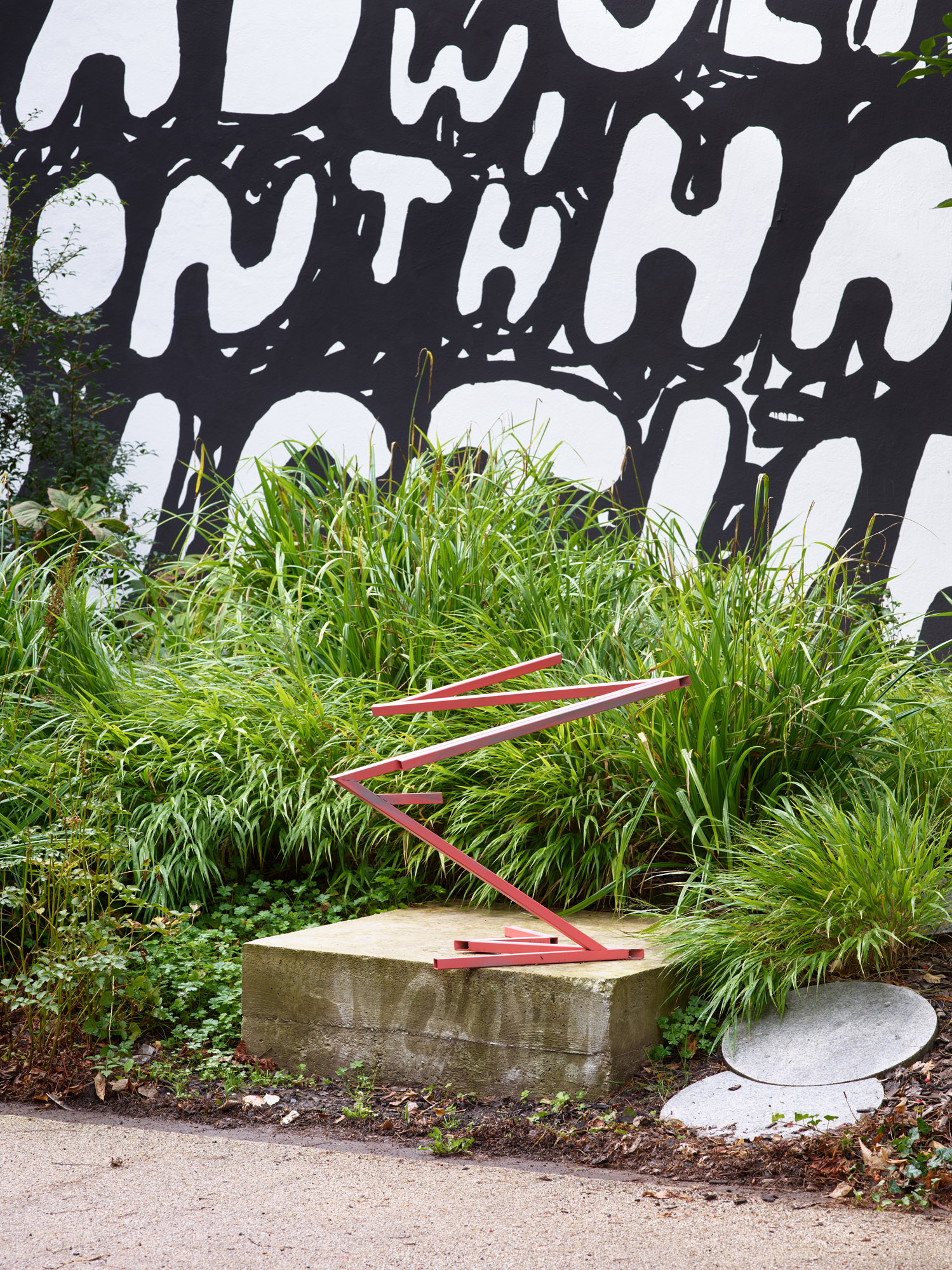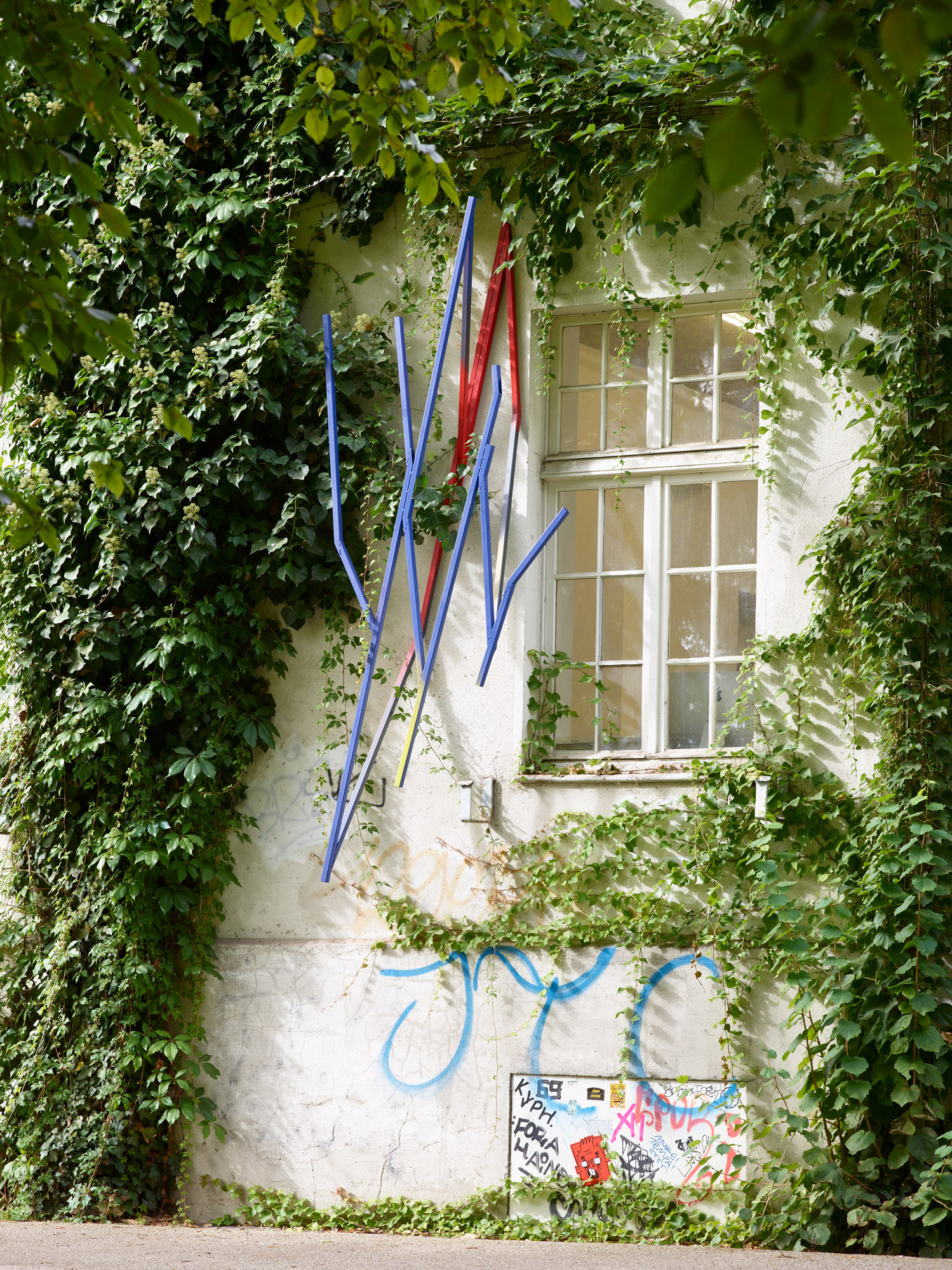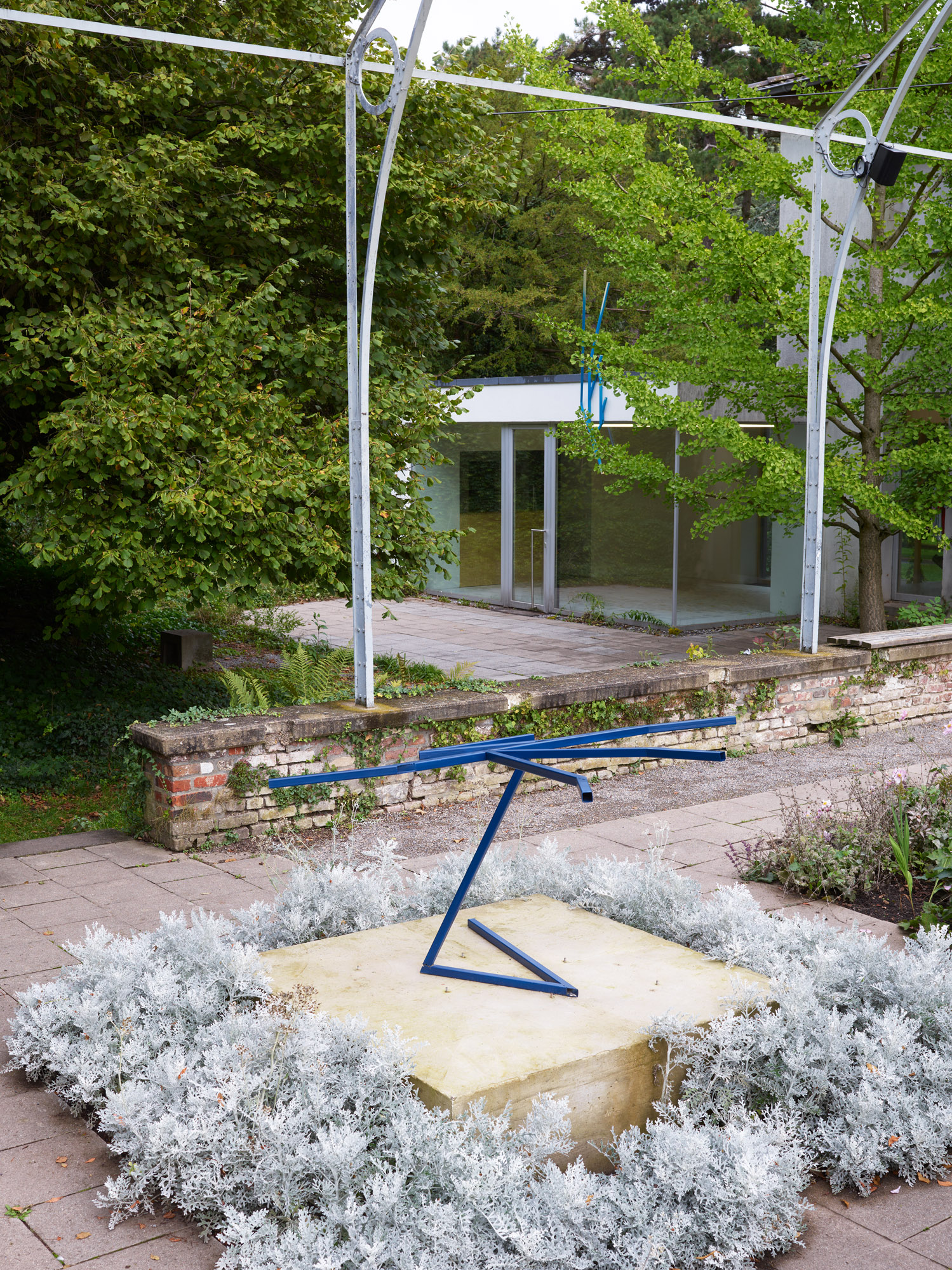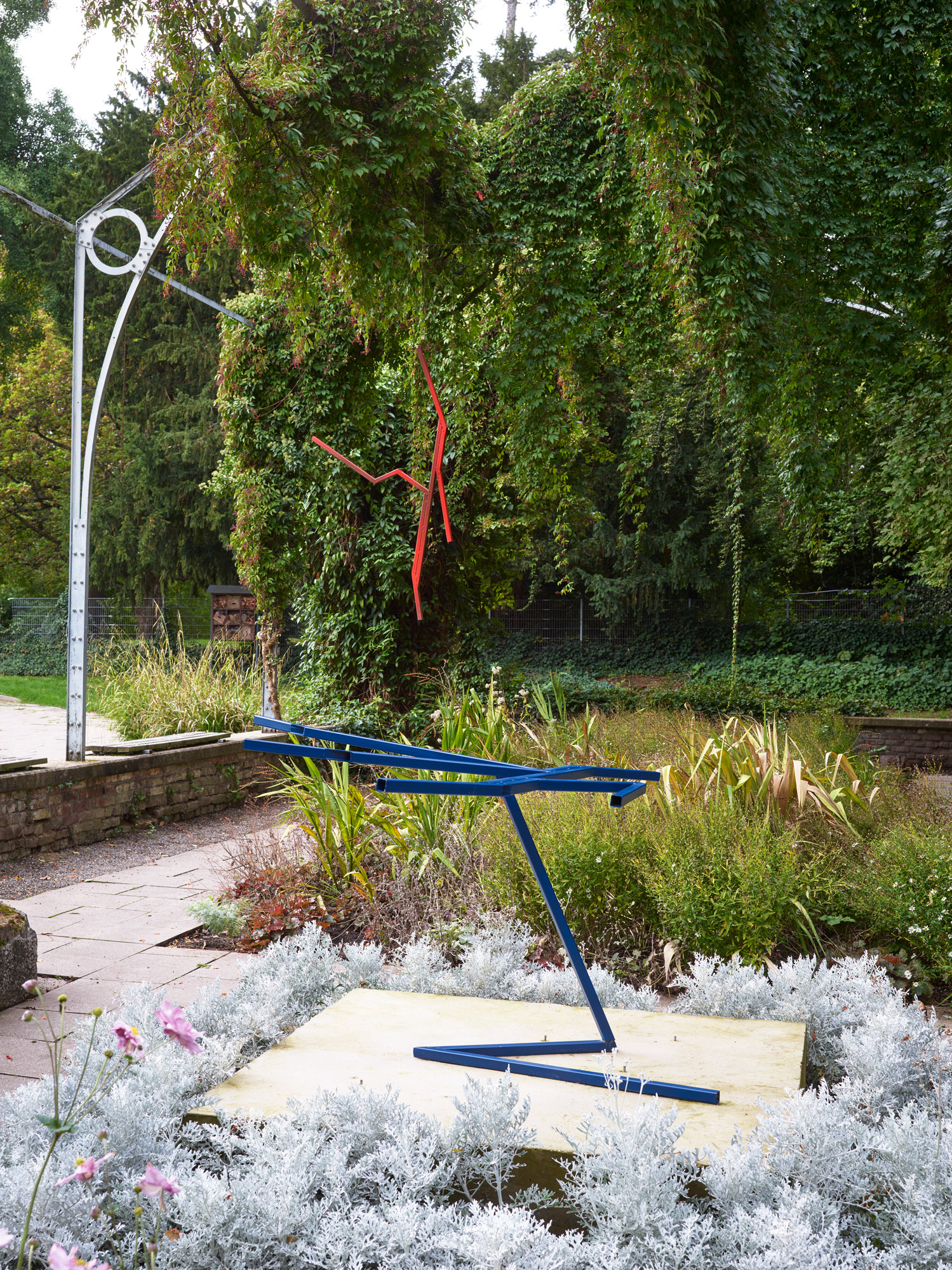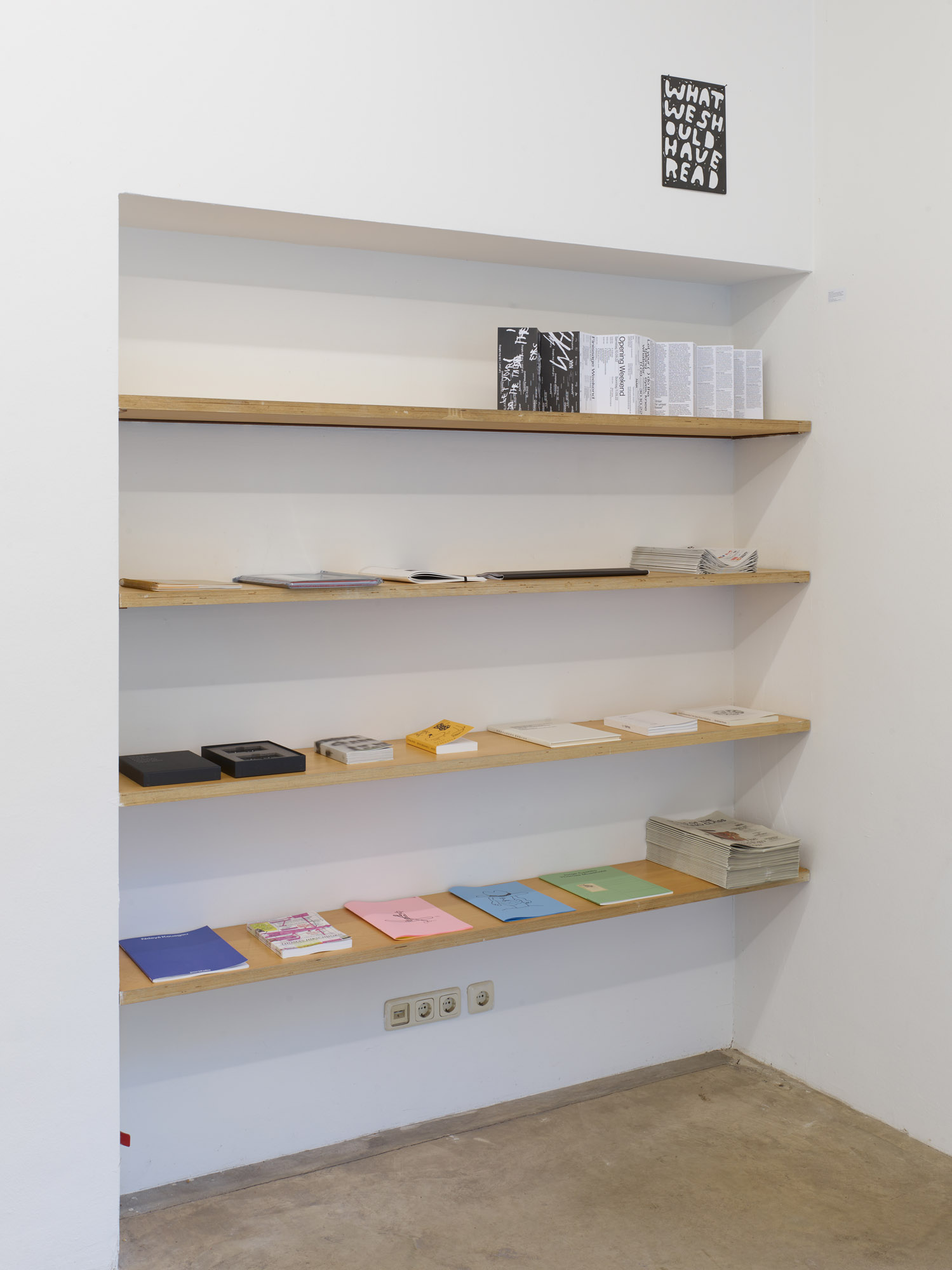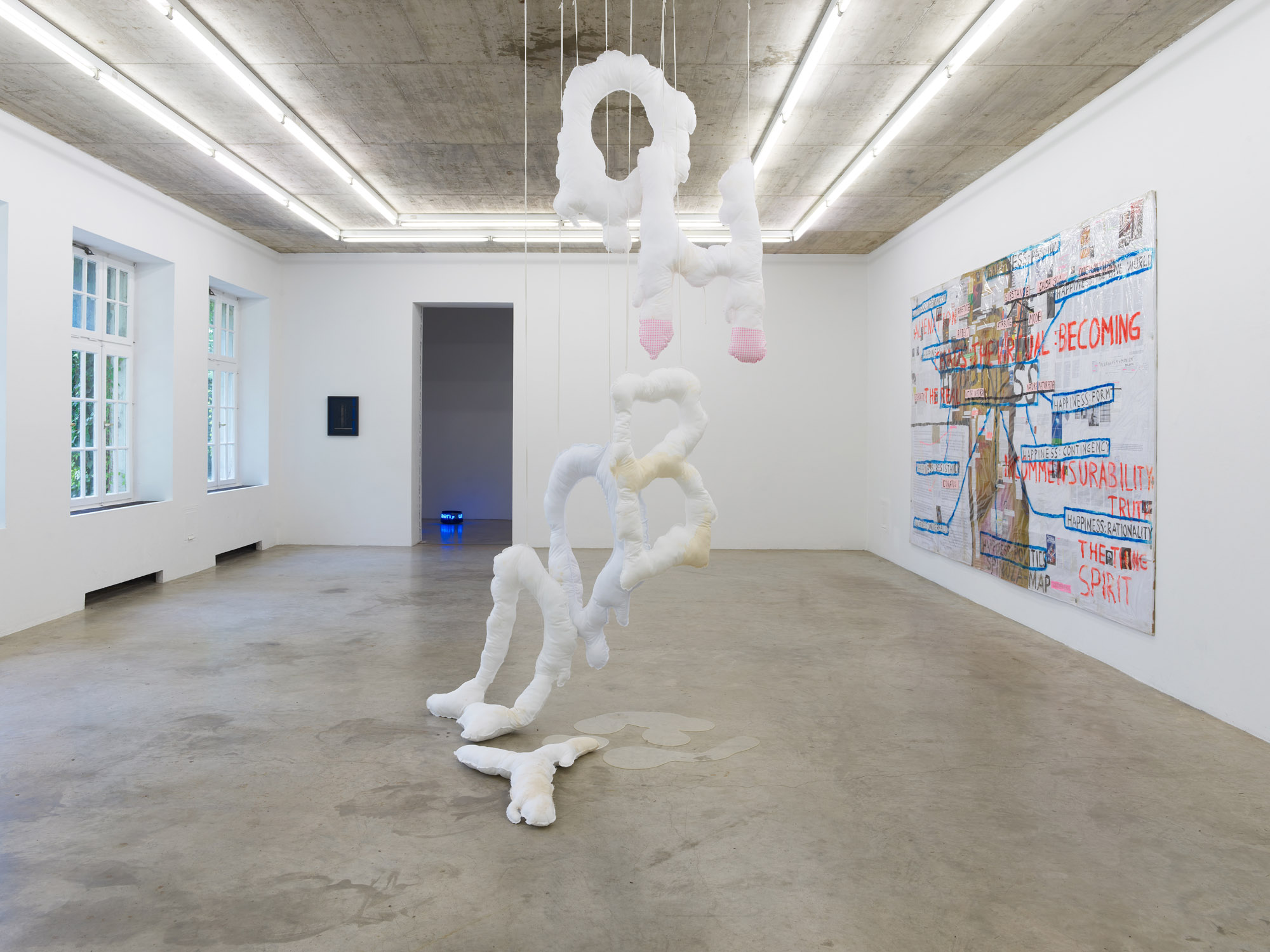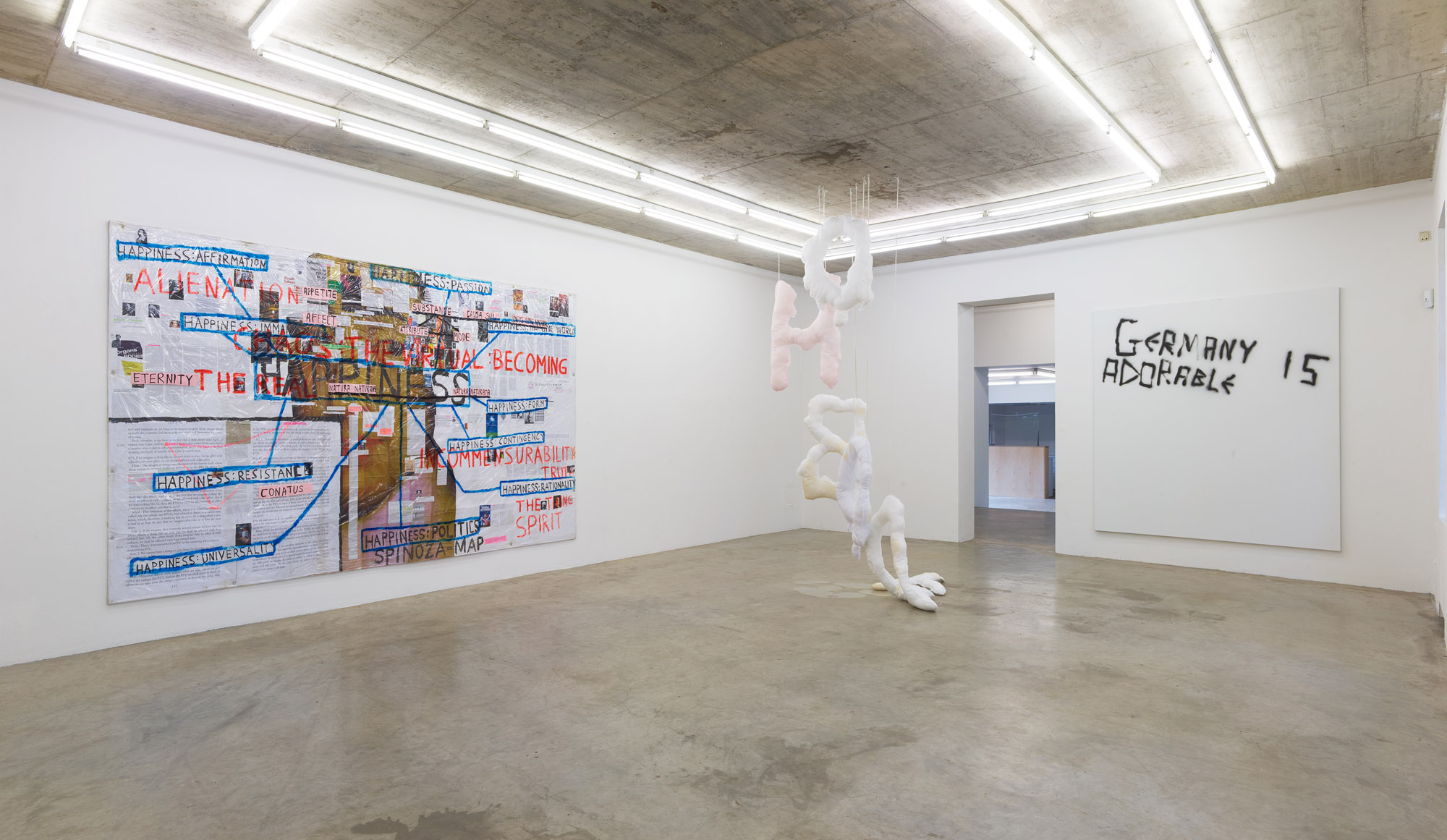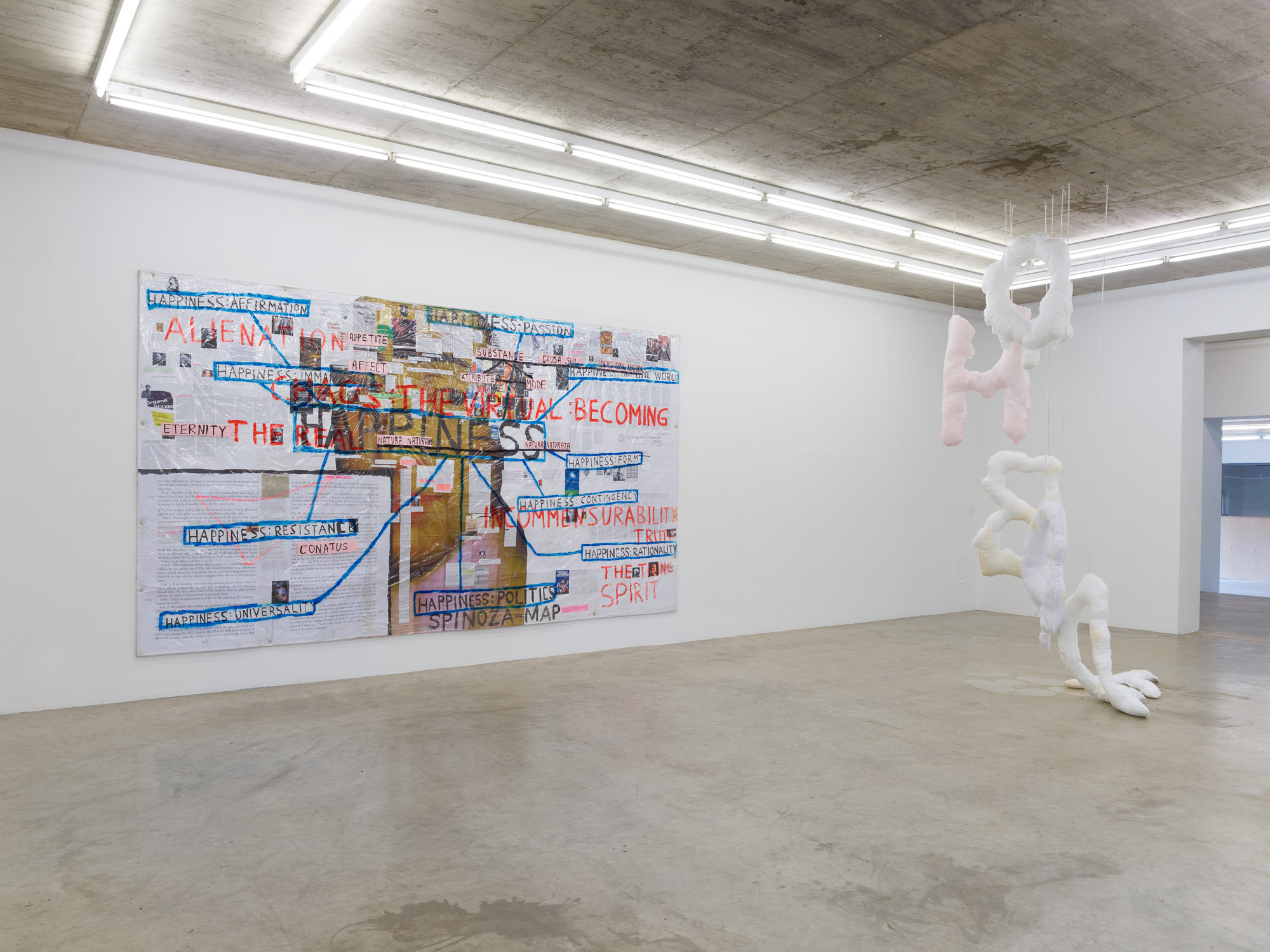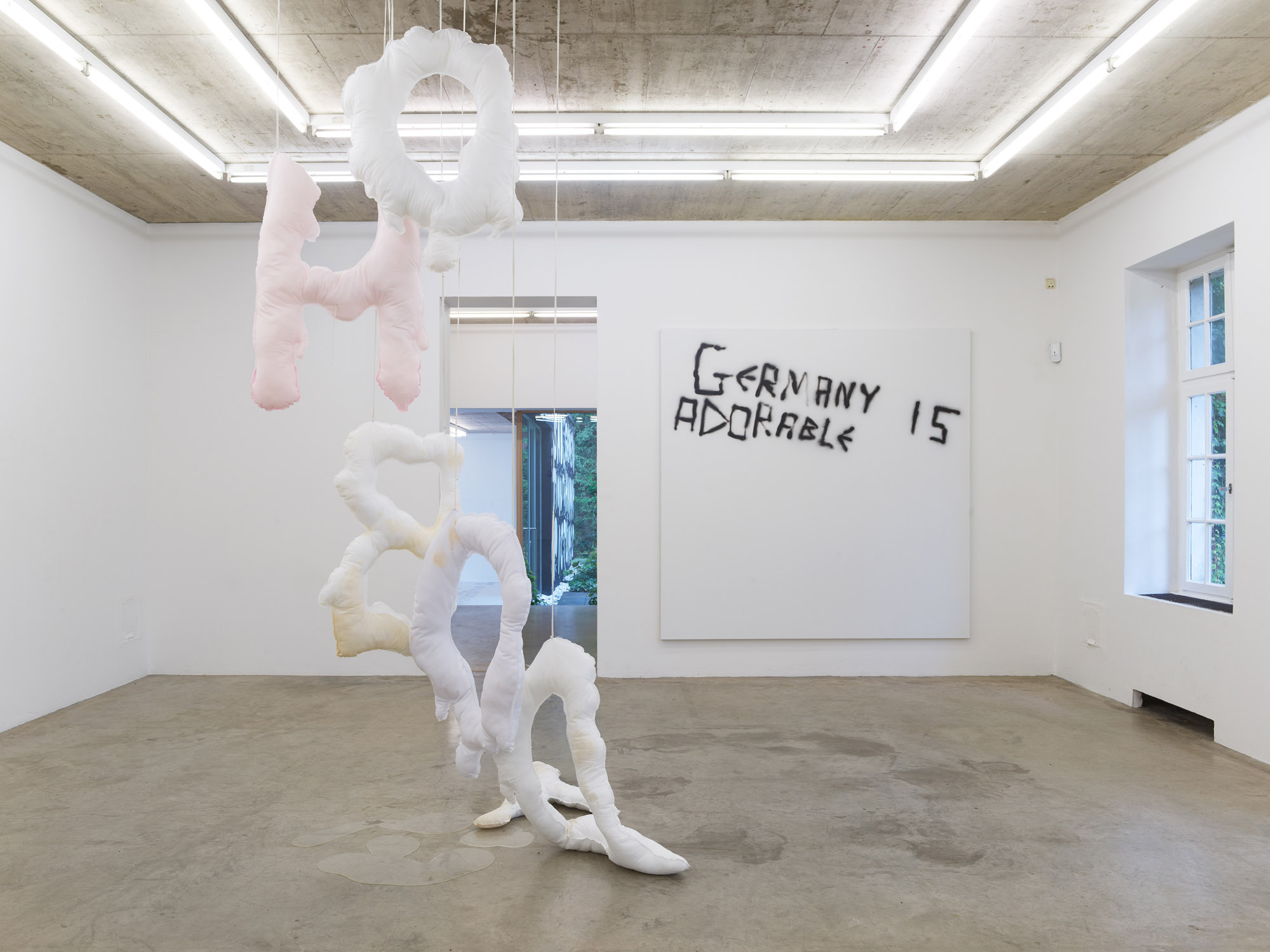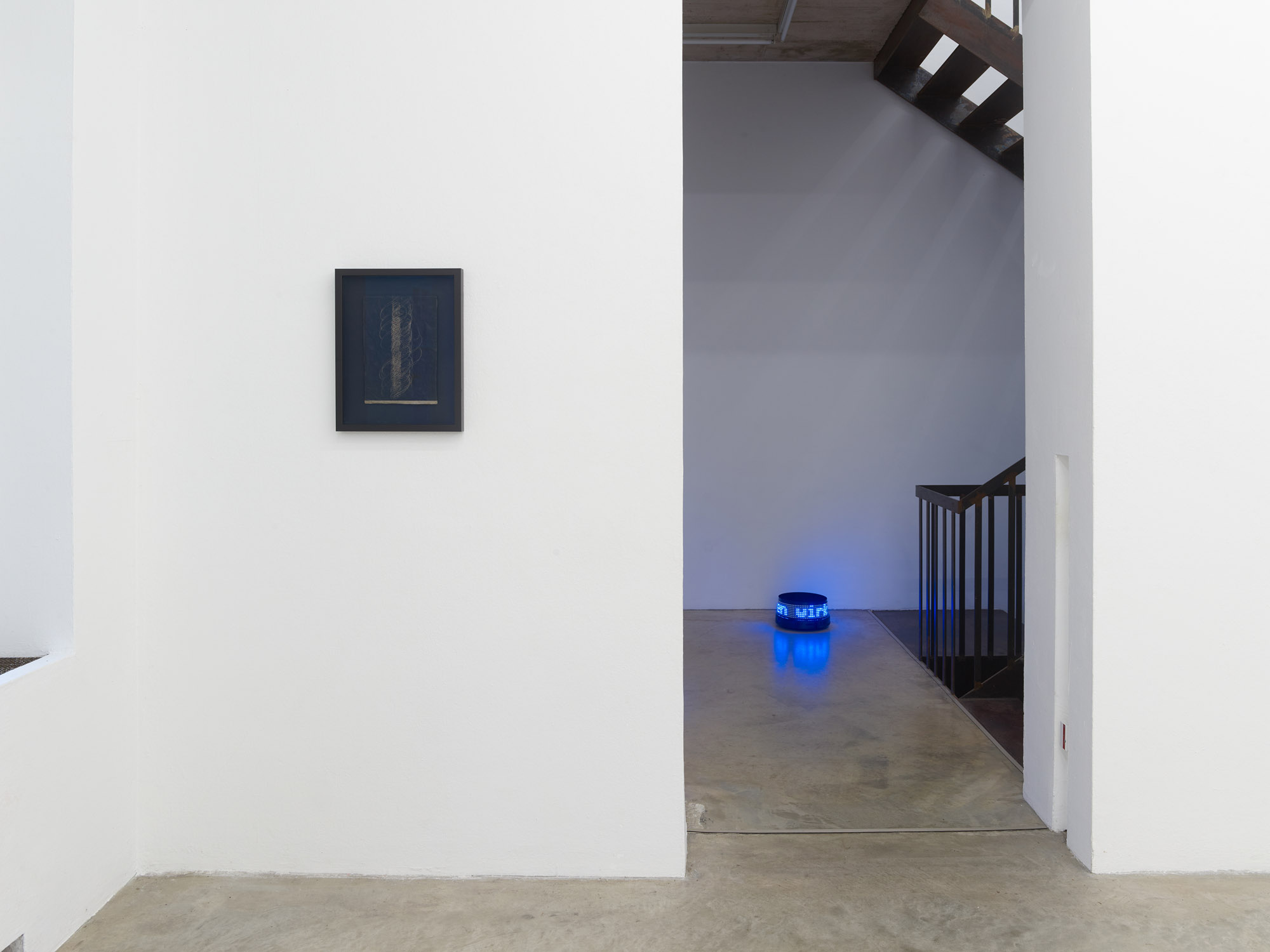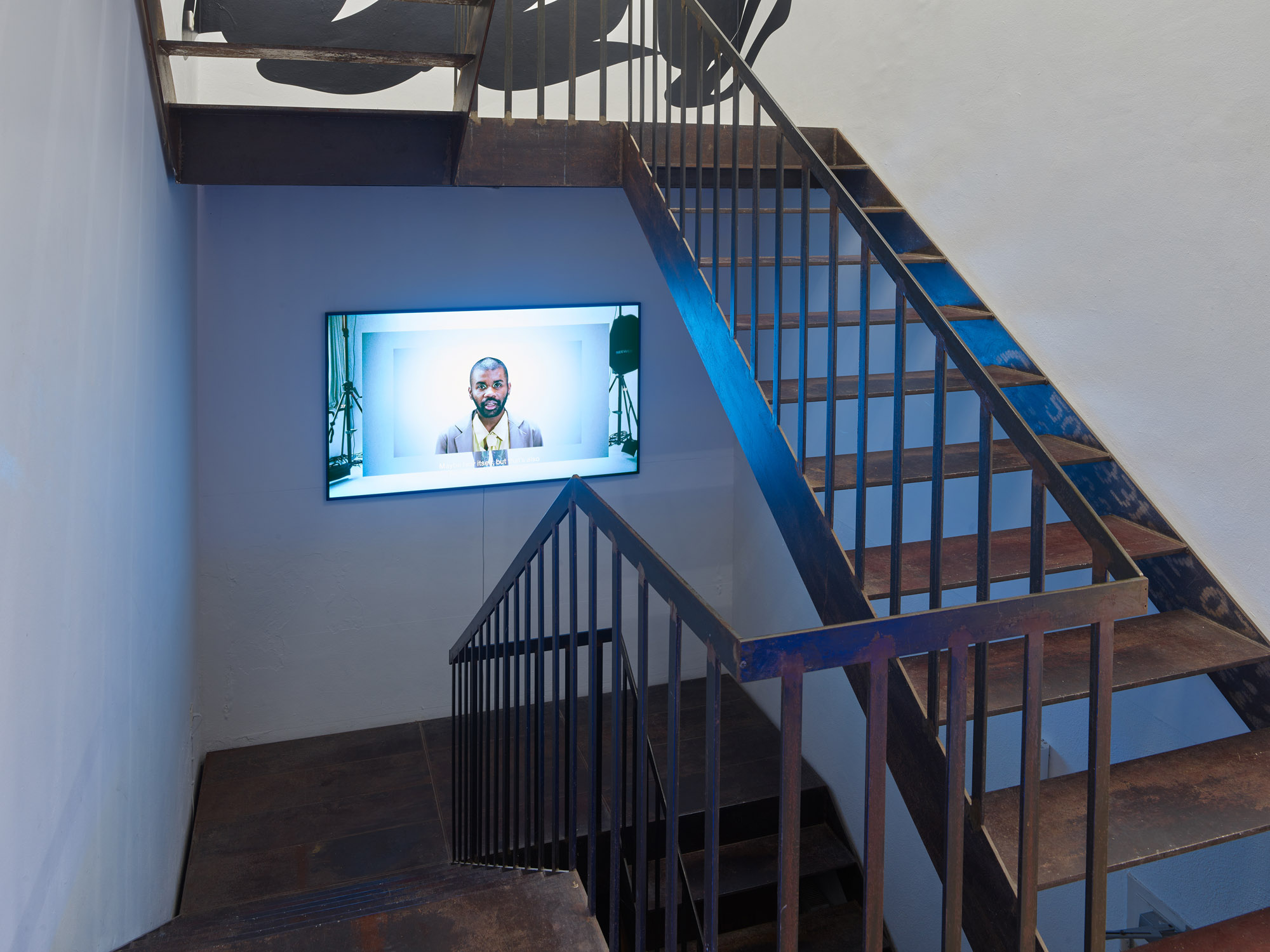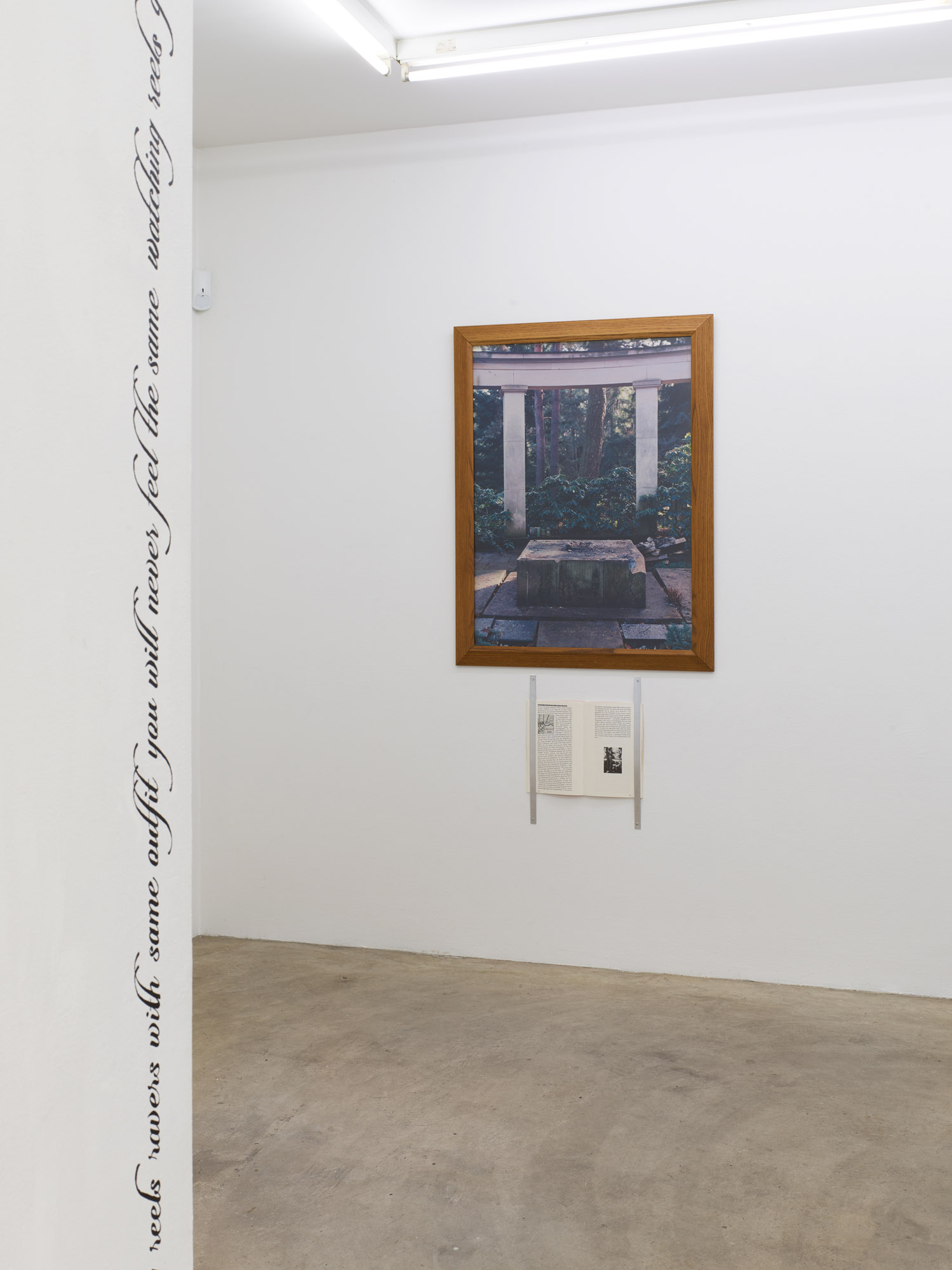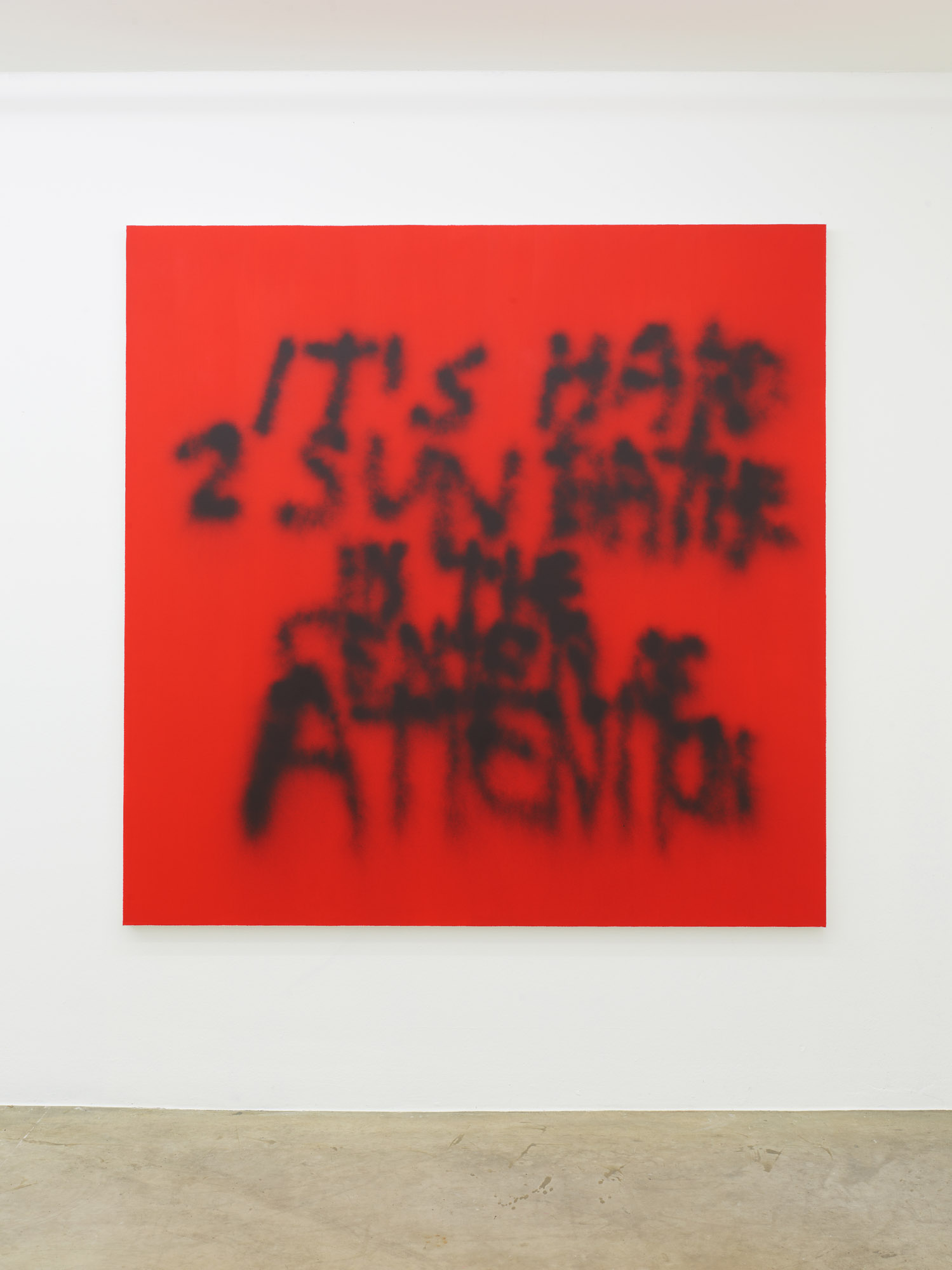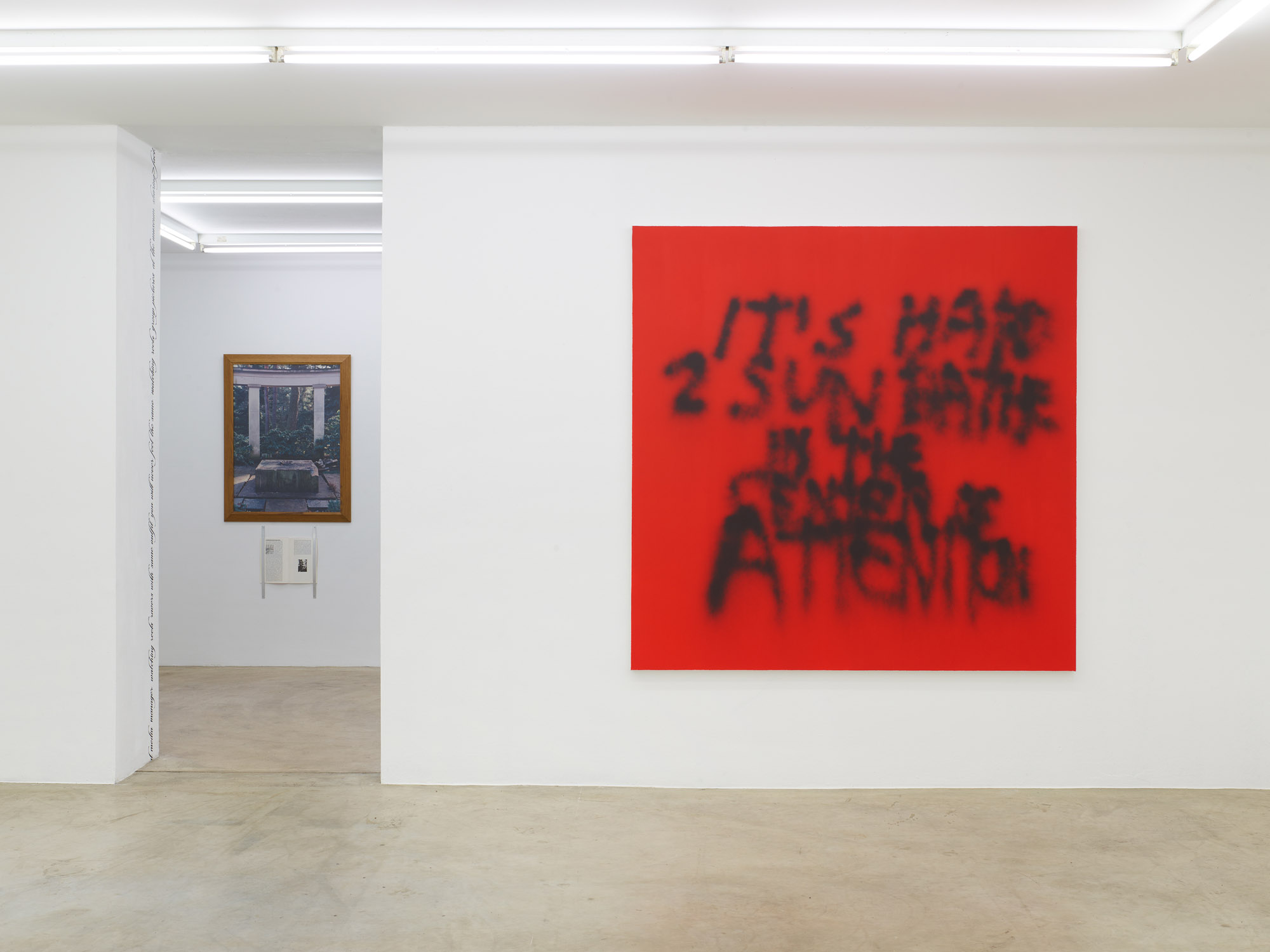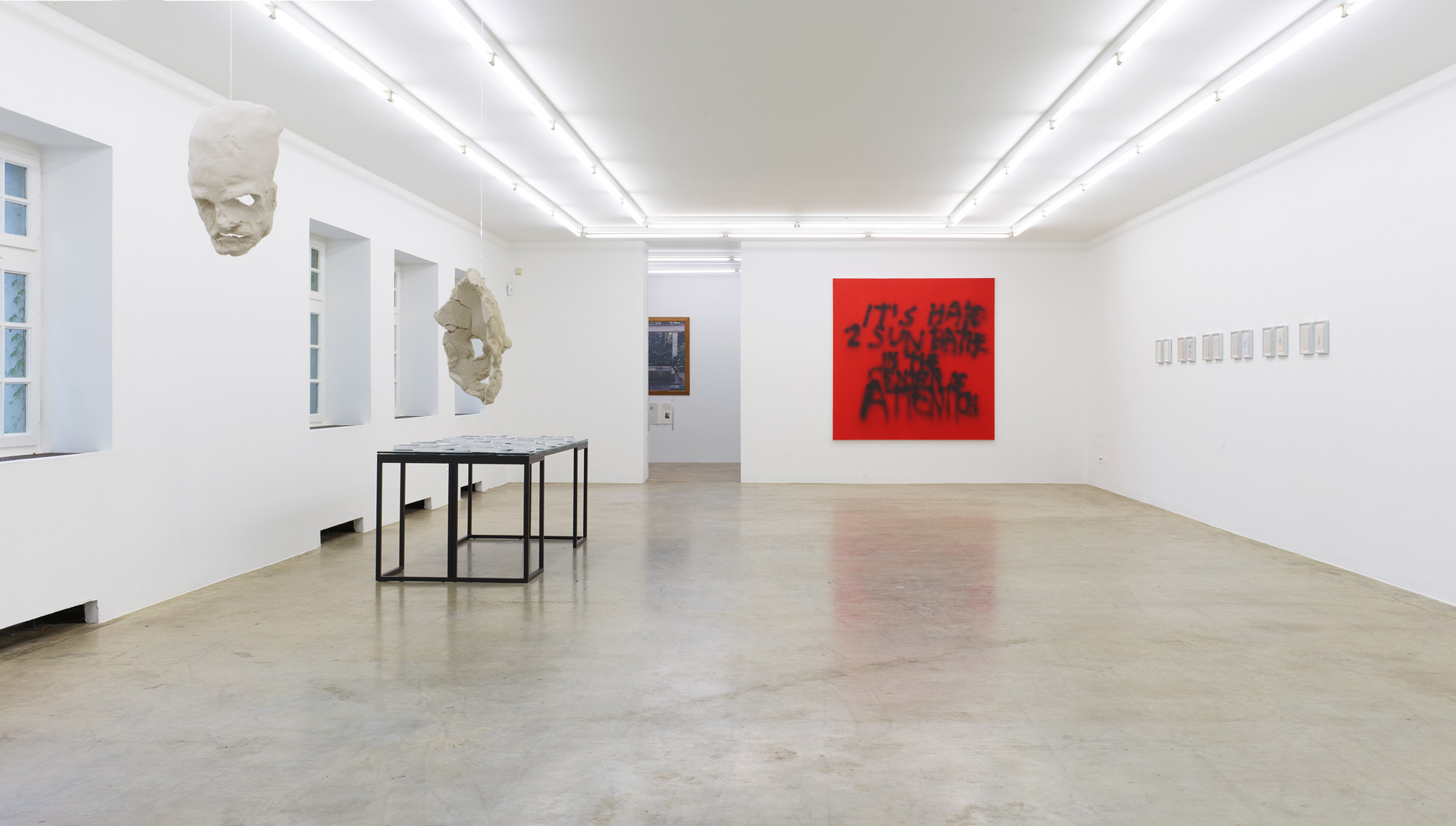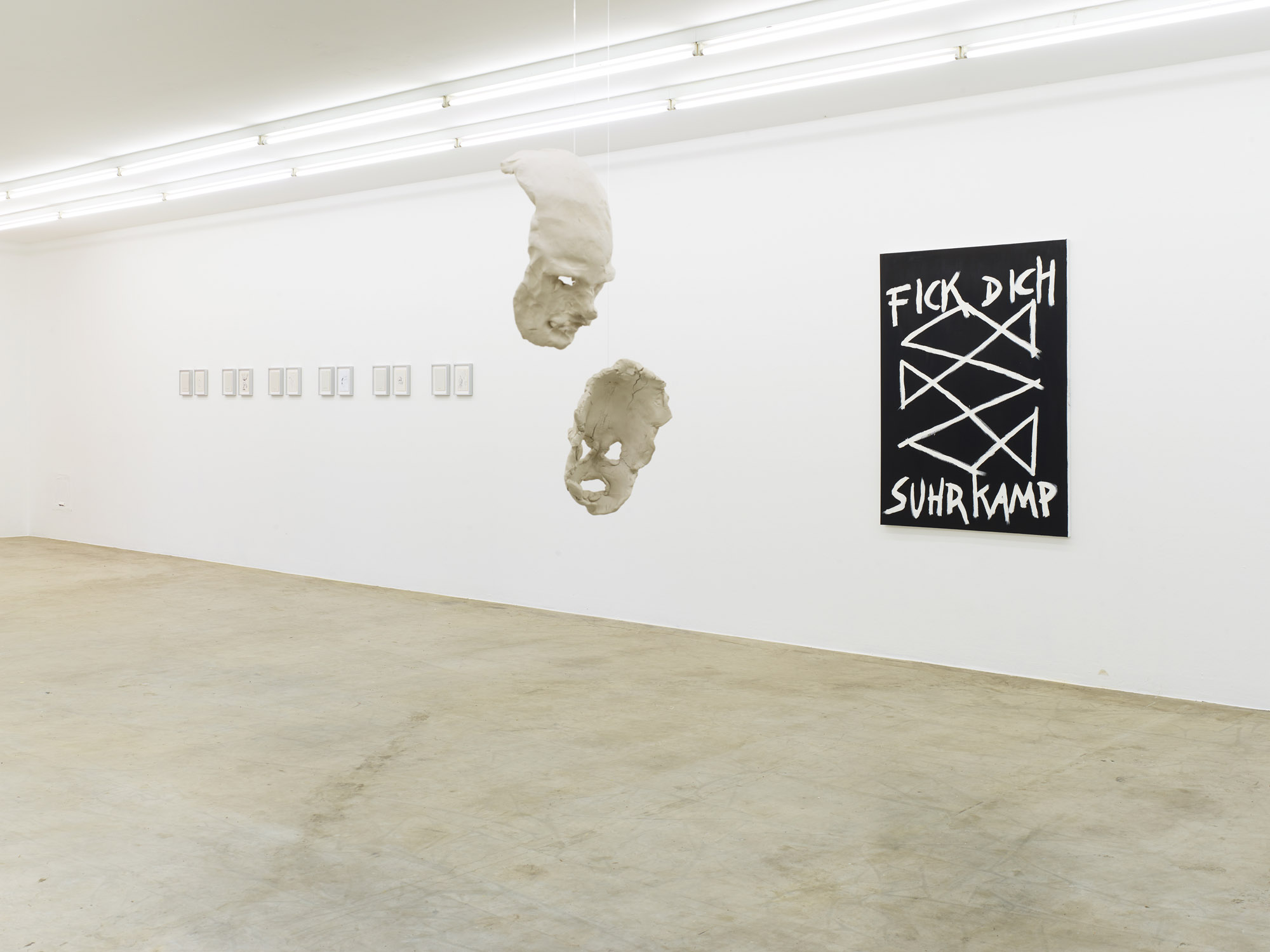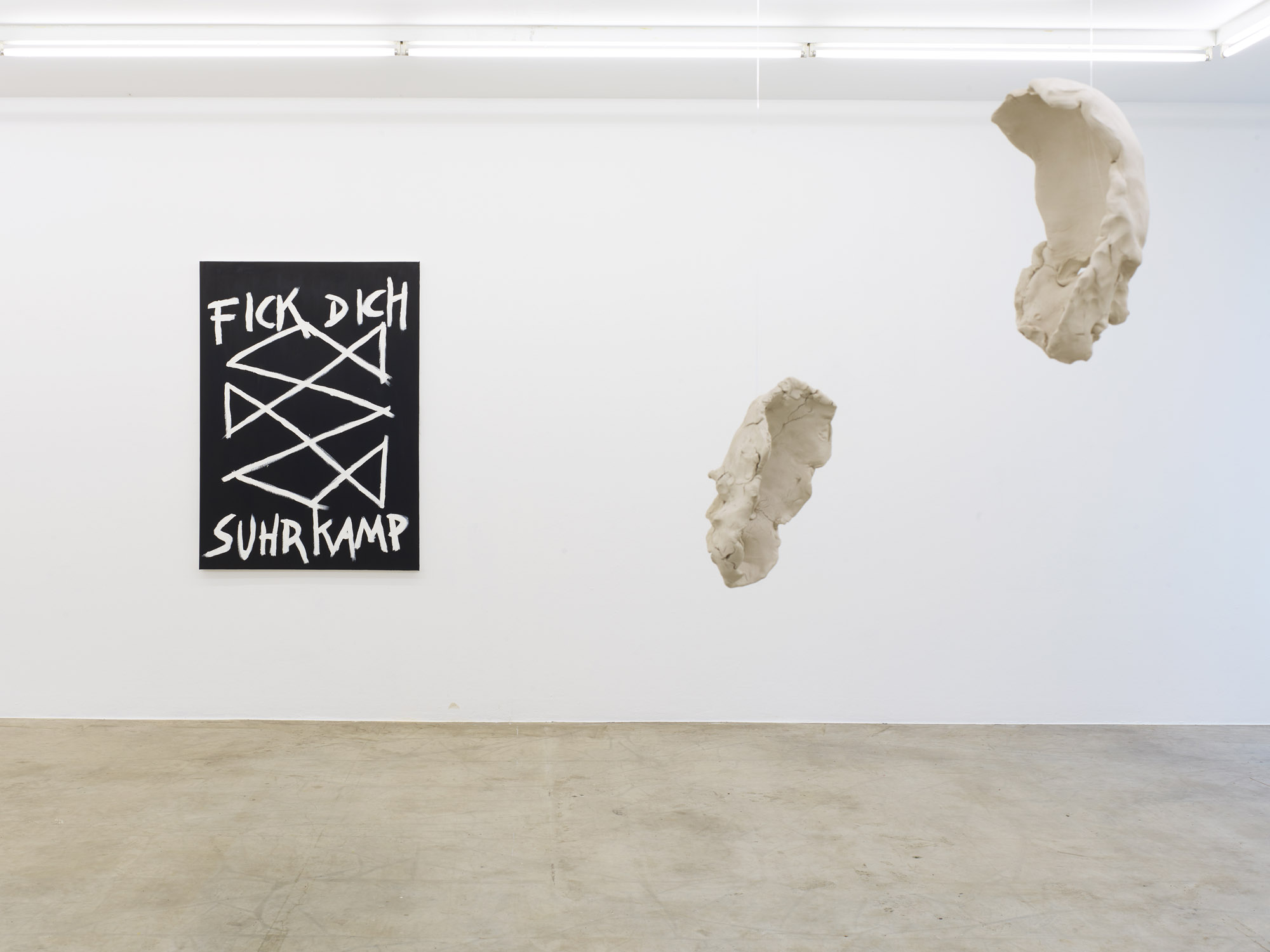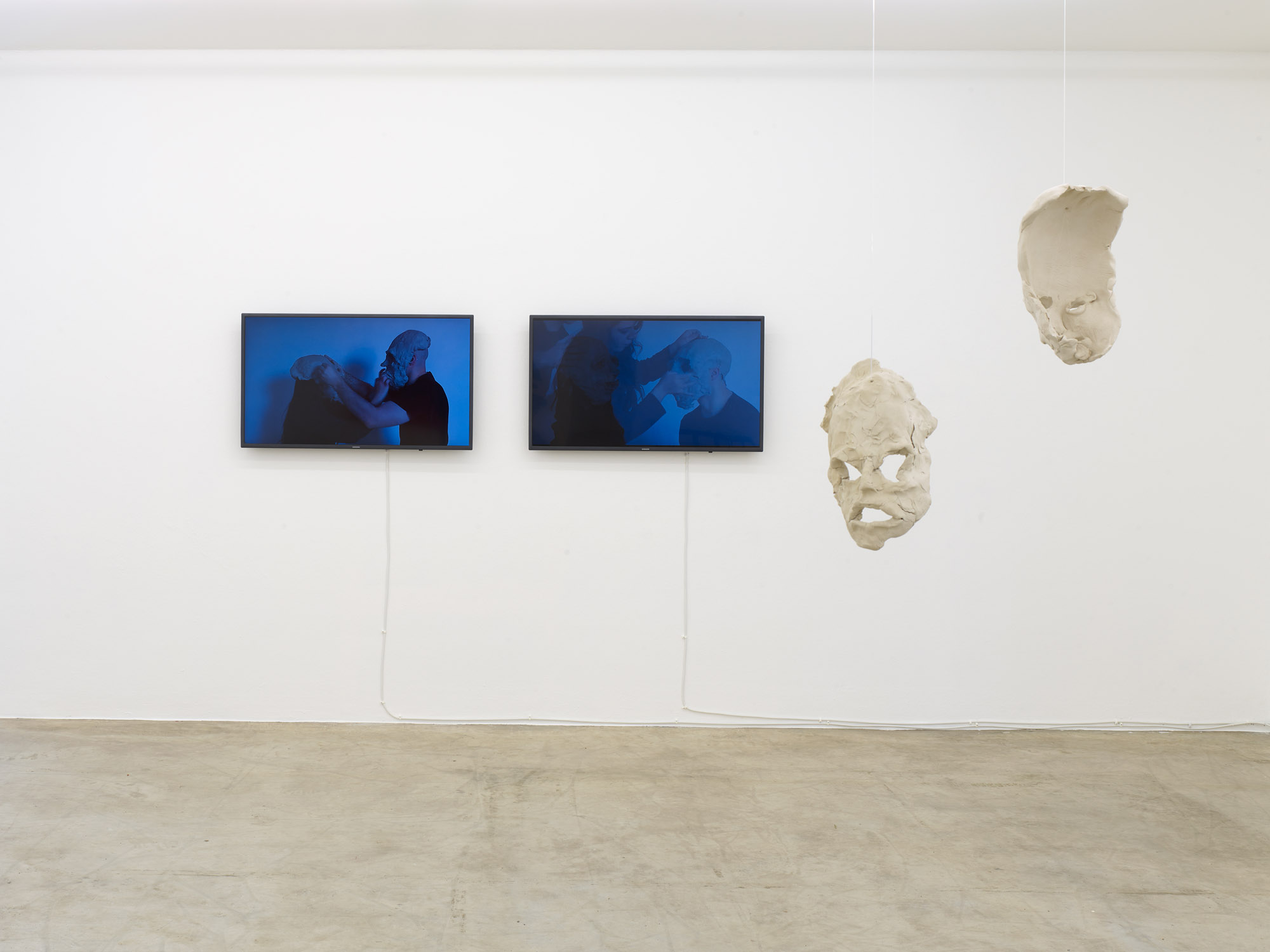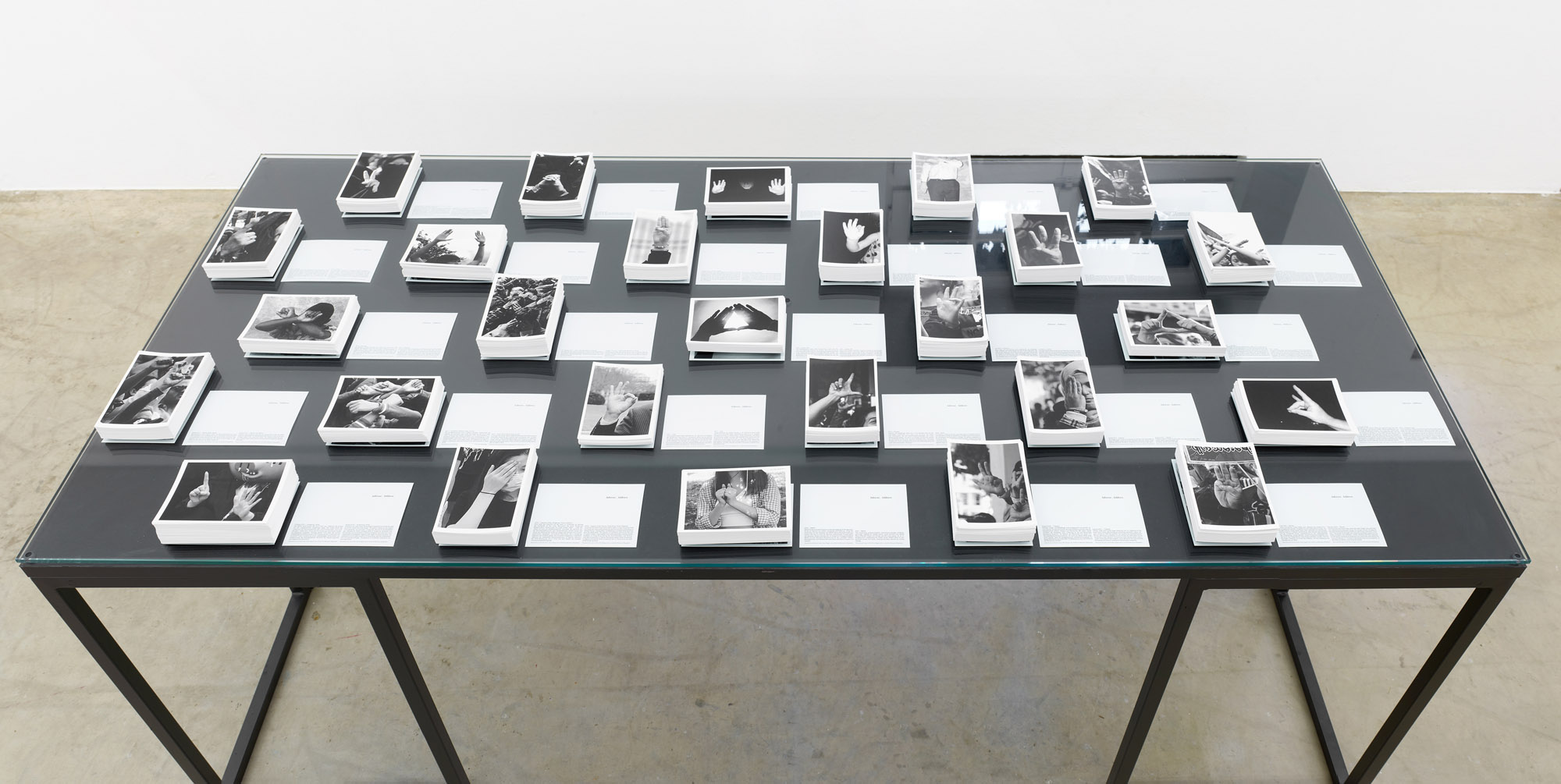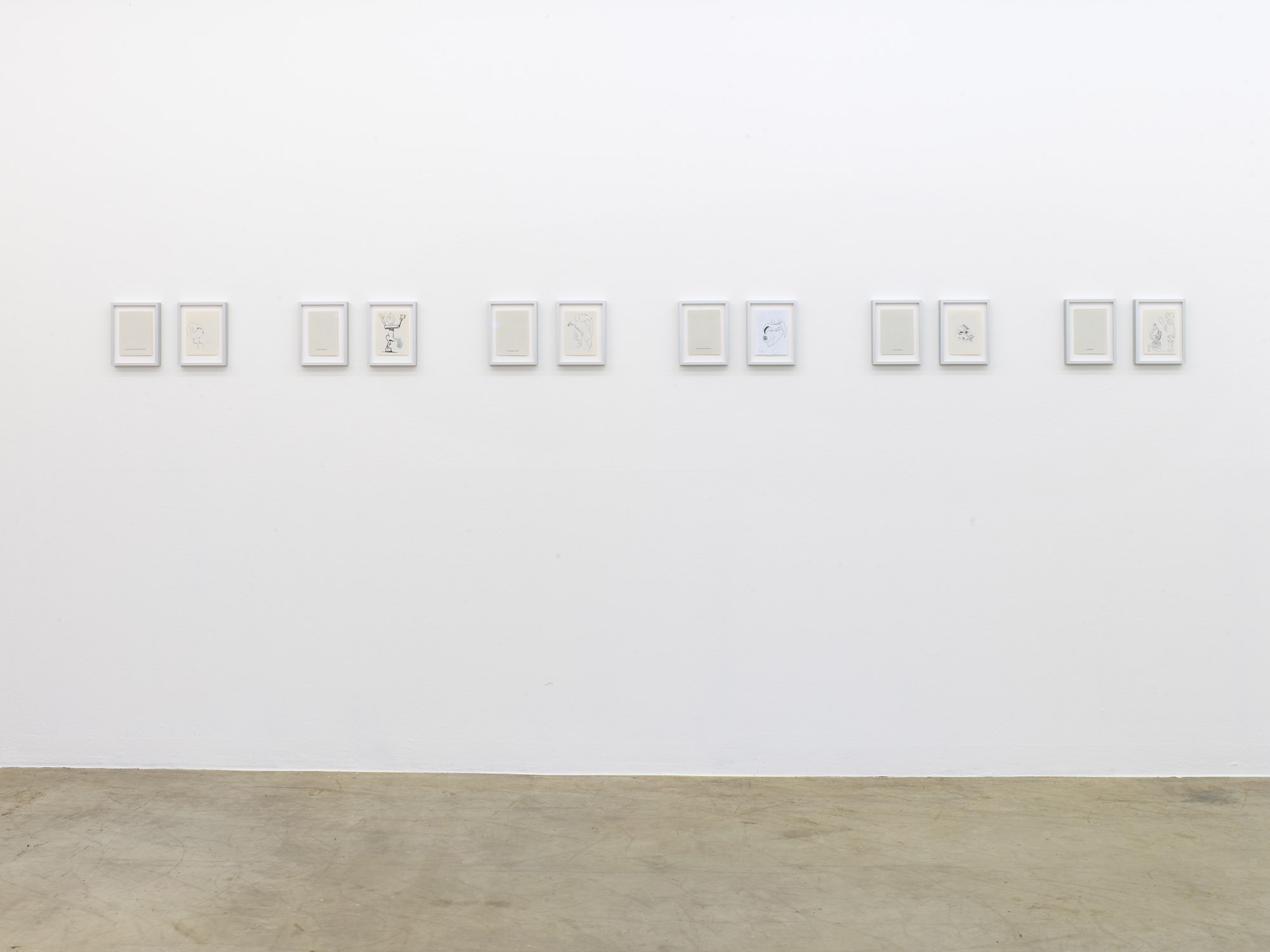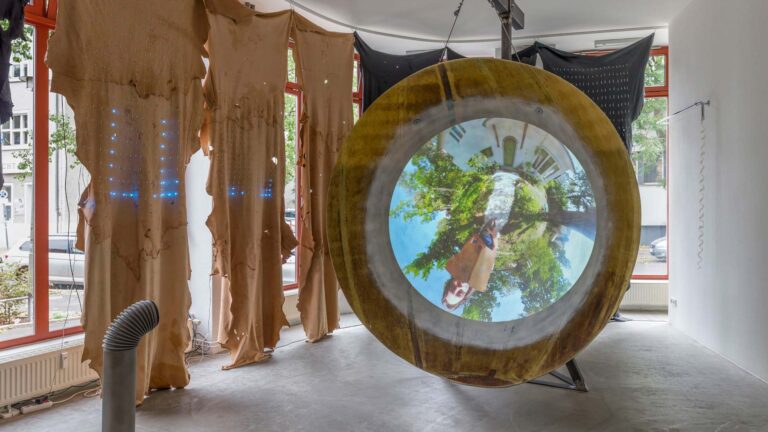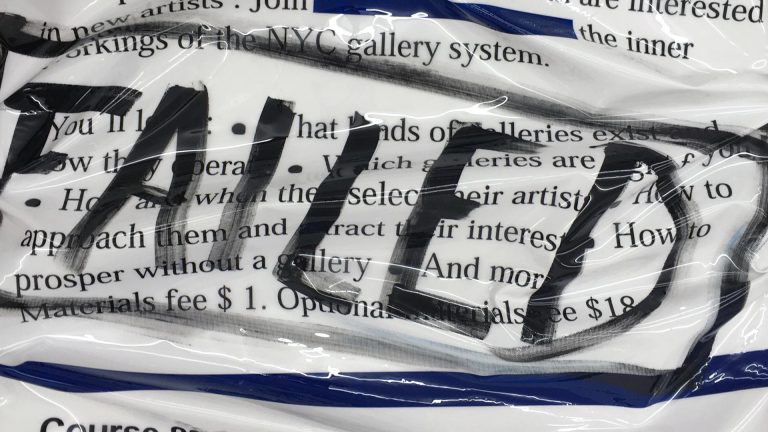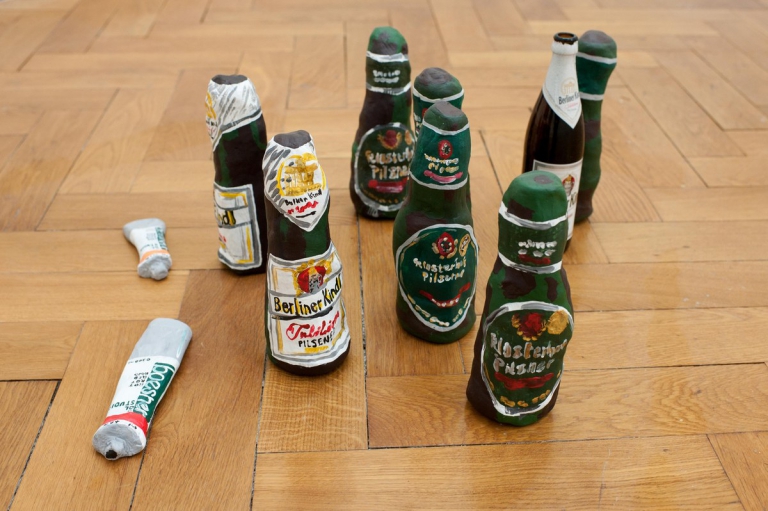Artists: Havin Al-Sindy, Arts Of The Working Class (Maria Inés Plaza & Jeronimo Voss), Sophie Calle, Kyrill Constantinides Tank, Richie Culver, Marcel Hiller, Thomas Hirschhorn, Artor Jesus Inkerö, Barbara Kapusta, Ndayé Kouagou, Inga Krüger, Mafia Tabak, Stefan Marx, James Mæssiah, Marianne Mispelaëre, Thomas Musehold, Boris Nieslony, Pms, Daniele Pusinanti, Johanna Reich, Monty Richthofen, Franca Scholz, Luki Von Der Gracht, Nicholas Warburg
Exhibition title: Let your ( ) do the talking, eyes knee whatever
Curated by: Luisa Schlotterbeck, Monty Richthofen & Maurice Funken
Venue: NAK Neuer Aachener Kunstverein, Aachen, Germany
Date: September 11 – October 30, 2022
Photography: all images copyright and courtesy of the artists and NAK Neuer Aachener Kunstverein
The exhibition Let your ( ) do the talking, eyes knee whatever opens September 10 and 11 at NAK Neuer Aachener Kunstverein.
The conceptual framework of the extensive group exhibition focuses on the experience of immediate, linguistic proximity; the exhibition seeks to reflect linguistic proximity-distance relationships as well as their poetic, political, or concrete effects. It is about the immersive experience of language; it is about the emotional experience of its meaningfulness or its nonsense and about the attempt to understand linguisticity as a sensitive and multifaceted organ with which we communicate and inscribe ourselves. This exhibition is not about dematerialization, but about an even more central component of the concept of the work.
We are accustomed to viewing works of art as manifestations of very specific, individual choices. We don’t want to define the recipients. They can do that themselves, if they wish. Quite in the spirit of Lawrence Weiners: the use of writing not to prescribe.[1] Often the beauty of language lies in its fragility, in its contradiction to a fixed norm, or in its refusal to conform to custom and propriety, or to the expectations that go with it (e.g. the expectation of its mistress, grammar); and this without necessarily being indecent. The linguistic intelligence of a dyslexic shows more of that brittleness than the linguistic onanism of rhetorical figures that putty and polish that very same brittleness. If we understand grammar, for example, as a set of rules of language, like a code that can be perfectly encoded and decoded, then one understands, but one no longer needs to communicate. Once you have perfectly decoded the language, you have reached the end. A misunderstanding keeps us awake, blanks make us search. Failure demands greater sensitivity and keeps us open to different readings[2] and expressions. Misunderstanding makes us pause and deepen in the in-between of our routinely dualistic truths. Perhaps the fallibility of language leads to new dialects. Perhaps an essence of linguistic communication lies in its incomprehensibility: perhaps it is good if it does not always go down like butter.
“The poet is always our contemporary.“[3]
Inviting artists from almost all age groups, as well as autodidacts and professional artists and writers, promotes both an intergenerational exchange, an alignment of languages, and a questioning of one’s own rhetoric. The exhibition will oscillate between different languages and the question of a universal understanding of language, seeking how language and voice occupy and balance different spaces in contemporary art; thus questioning different aspects of the understanding of linguisticity and beauty or ugliness. In addition to the works gathered in the group exhibition, performers and authors are invited to share their chosen contributions and communicate through visual, auditory, or performative interventions. Readings and book presentations or discussion-seeking encounters are also planned. Out of the rooms, in situ works and commentaries stretch along the building, through the Kurpark and out into the city. The exhibition argues inter- or transdisciplinary and is broad in the represented genres, formats and media.
The exhibition is organized and curated by Luisa Schlotterbeck (Artistic Director, Neue Galerie Gladbeck), Monty Richthofen (Artist) and Maurice Funken (Director, NAK Neuer Aachener Kunstverein). Exhibition text by Luisa Schlotterbeck.
[1] See Joachim Büthe, Lawrence Weiner: Gefragt und Gesagt, 02.05.2005, Deutschlandfunk.
[2] For example, Ingeborg Bachmann’s Udine theme could also be understood in a non-feminist reading. Is Udine the art and we the Horst people?
[3] Virginia Woolf, Wie man ein Buch lesen soll?, in: Granit und Regenbogen. Essays., 1960, 9-24.
Stefan Marx, Sad Generation With Happy Pictures, 2021. Courtesy: the artist. Marcel Hiller, NEW, 2021/2022. Courtesy: the artist
Stefan Marx, Sad Generation With Happy Pictures, 2021. Courtesy: the artist. Marcel Hiller, NEW, 2021/2022. Courtesy: the artist
Marcel Hiller, SKIN, 2019/2020. Courtesy: the artist
Marcel Hiller, SKIN, 2019/2020. Courtesy: the artist
Marcel Hiller, LESS, 2019/2022. Courtesy: the artist
Marcel Hiller, WET, 2021. Courtesy: the artist
James Mæssiah, Lucky / Gone West, 2021. Courtesy: the artist; Marcel Hiller, WET, 2021. Courtesy: the artist; Marcel Hiller, WE, 2021/2022. Courtesy: the artist
Marcel Hiller, WET, 2021. Courtesy: the artist; Marcel Hiller, LESS, 2019/2022. Courtesy: the artist; James Mæssiah, Lucky / Gone West, 2021. Courtesy: the artist.
Marcel Hiller, WET, 2021. Courtesy: the artist; Marcel Hiller, WE, 2021/2022. Courtesy: the artist
Boris Nieslony, Performance Art-Kontext von Gerard Dirmoser und Boris Nieslony, 1993/1999-2001. Courtesy: the artist
Daniele Pusinanti, Watching Reels, 2022. Courtesy: the artist; Johanna Reich, Flusser Bots, 2022. Courtesy: the artist; Franca Scholz, Oh Body, 2020. Courtesy: the artist; Stefan Marx, What We Should Have Read, 2022. Courtesy: the artist; PMS, T-shirts And Longsleeves, 2022. Courtesy: the artist
Stefan Marx, What We Should Have Read, 2022. Courtesy: the artist
Daniele Pusinanti, Watching Reels, 2022. Courtesy: the artist; Johanna Reich, Flusser Bots, 2022. Courtesy: the artist; Franca Scholz, Oh Body, 2020. Courtesy: the artist; Thomas Hirschhorn, Spinoza-Map, 2007. Courtesy: Sammlung Peters-Messer
Thomas Hirschhorn, Spinoza-Map, 2007. Courtesy: Sammlung Peters-Messer; Franca Scholz, Oh Body, 2020. Courtesy: the artist; Richie Culver, Germany Is Adorable, 2022. Courtesy: the artist and Ruttkowski;68
Franca Scholz, Oh Body, 2020. Courtesy: the artist; Daniele Pusinanti, Watching Reels. 2022, Courtesy: the artist; Johanna Reich, Flusser Bots, 2022. Courtesy: the artist
Thomas Hirschhorn, Spinoza-Map, 2007. Courtesy: Sammlung Peters-Messer; Franca Scholz, Oh Body, 2020. Courtesy: the artist
Franca Scholz, Oh Body, 2020, Courtesy: the artist; Richie Culver, Germany Is Adorable, 2022. Courtesy: the artist and Ruttkowski;68
Thomas Hirschhorn, Spinoza-Map, 2007. Courtesy: Sammlung Peters-Messer
Daniele Pusinanti, Watching Reels, 2022. Courtesy: the artist; Johanna Reich, Flusser Bots, 2022. Courtesy: the artist
Daniele Pusinanti, Watching Reels, 2022. Courtesy: the artist; Johanna Reich, Flusser Bots, 2022. Courtesy: the artist
Ndayé Kouagou, A Coin Is A Coin, 2022. Courtesy: the artist and Nir Altman
Barbara Kapusta, A New Fiery Community, 2022. Courtesy: the artist
Daniele Pusinanti, Watching Reels, 2022. Courtesy: the artist; Sophie Calle, Die Entfernung Soldat (Sowjetischer Ehrenfriedhof), 2022. Courtesy: Sammlung Peters-Messer
Monty Richthofen, IT’S HARD TO SUNBATHE IN THE CENTER OF ATTENTION, 2022. Courtesy: the artist
Daniele Pusinanti, Watching Reels, 2022. Courtesy: the artist; Sophie Calle, Die Entfernung Soldat (Sowjetischer Ehrenfriedhof), 2022. Courtesy: Sammlung Peters-Messer; Monty Richthofen, IT’S HARD TO SUNBATHE IN THE CENTER OF ATTENTION, 2022. Courtesy: the artist
Havin Al-Shindy, Personae, 2019-2020. Courtesy: the artist; Marianne Mispelaëre, Silent Slogan, 2016/2022 (fortlaufend/ongoing), Courtesy: the artist; Sophie Calle, Die Entfernung Soldat (Sowjetischer Ehrenfriedhof), 2022. Courtesy: Sammlung Peters-Messer; Monty Richthofen, IT’S HARD TO SUNBATHE IN THE CENTER OF ATTENTION, 2022. Courtesy: the artist; Kyrill Constantinides Tank, 6 Zeichnungen mit Titel, 2018. Courtesy: the artist
Nicholas Warburg, Titelbild 3, 2020. Courtesy: Sammlung Peters-Messer; Havin Al-Shindy, Personae, 2019-2020. Courtesy: the artist; Marianne Mispelaëre, Silent Slogan, 2016 /2022 (fortlaufend/ongoing). Courtesy: the artist
Kyrill Constantinides Tank, 6 Zeichnungen mit Titel, 2018. Courtesy: the artist; Havin Al-Shindy, Personae, 2019-2020. Courtesy: the artist; Nicholas Warburg, Titelbild 3, 2020. Courtesy: Sammlung Peters-Messer
Nicholas Warburg, Titelbild 3, 2020. Courtesy: Sammlung Peters-Messer; Havin Al-Shindy, Personae, 2019-2020. Courtesy: the artist
Havin Al-Shindy, Personae, 2019-2020. Courtesy: the artist
Nicholas Warburg, Titelbild 3, 2020. Courtesy: Sammlung Peters-Messer; Marianne Mispelaëre, Silent Slogan, 2016/2022 (fortlaufend/ongoing). Courtesy: the artist; Havin Al-Shindy, Personae, 2019-2020. Courtesy: the artist.
Marianne Mispelaëre, Silent Slogan, 2016/2022 (fortlaufend/ongoing). Courtesy: the artist
Kyrill Constantinides Tank, 6 Zeichnungen mit Titel, 2018. Courtesy: the artist


